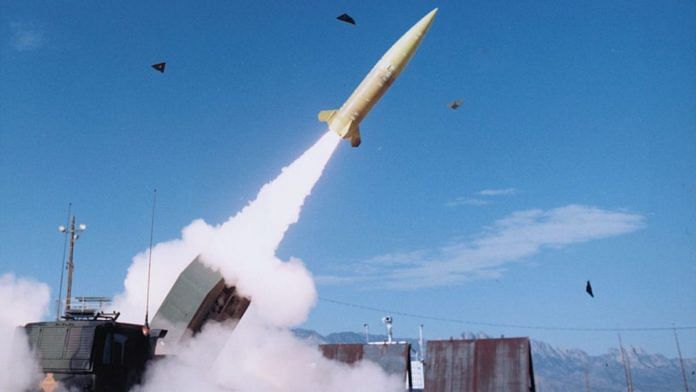New Delhi: In a significant development, Ukraine has used US-supplied ATACMS missiles to conduct high-precision strikes, in this case, on two airfields in areas under Russian control, one in Luhansk in Donbas and the other in Berdyansk along the Sea of Azov.
Ukraine’s admission now proves that the US, which had been dithering over supplying Kyiv with these missiles with a range of 300 km, has finally done so.
The ATACMS, which carries cluster munitions inside instead of a unitary warhead, allows Ukrainian forces to hit Russian targets deep inside enemy territory and cause more damage than the ones supplied by the US until now. Russia has said that the transfer of missiles to Ukraine was a grave mistake that will have serious consequences.
Ukrainian President Volodymyr Zelenskyy in a video address on 17 October thanked the US for supplying the long-range guided missiles, adding that “agreements with President Biden” are being implemented. “Very accurately — ATACMS proved themselves,” he said.
ATACMS have proven themselves.
📹: @GeneralStaffUA pic.twitter.com/Sd9rYYbkwe
— Defense of Ukraine (@DefenceU) October 18, 2023
According to the German think tank Kiel Institute for the World Economy, Washington has directed more than $70 billion in assistance to Kyiv since Russia launched a full-scale invasion of its neighbour on 24 February 2022. As has been reported widely, Kyiv had repeatedly asked the Biden administration for ATACMS to bolster its efforts to disrupt Russian supply lines by attacking air bases and rail networks in controlled territory.
The Army Tactical Missile System (ATACMS) is a long-range guided ballistic missile manufactured by the US’s Lockheed Martin. With a maximum range of 300 km, this surface-to-surface artillery weapon system is capable of striking enemy targets beyond the range of existing cannons, rockets and other missiles.
What makes the ATACMS potent is its range and ability to carry cluster munitions.
ATACMS is launched from the HIMARS — which is already part of Ukraine’s arsenal — while MLRS M270 platforms is a self-propelled, rocket-artillery system.

The US has already supplied Ukraine with cluster-munitions, which destroy a targeted area by releasing hundreds of bomblets instead of a single warhead. And since the airfield in Berdyansk was hit using multiple missiles, it is important to note that the closest Ukrainian troop deployment on the western bank of the Dnieper River is just about 160 km from the city.
Ukraine was insistent on procuring such a weapon system which would allow it to strike deep behind Russian lines while keeping away from the firing range.
Though they are effective in hitting multiple targets at once, cluster munitions are banned for use by more than 100 countries including many NATO allies who are against the use of such weapons because they have the potential to cause grave civilian casualties. Munitions that remain unexploded in the battlefield can remain active and explode later.
The US has over the last year delivered cluster munitions in the form of 155 mm artillery rounds to Ukraine, which had a maximum range of 18 miles and could carry up to 48 bomblets. Russia, Ukraine and the US are not among the 112 signatories to the 2008 Convention on Cluster Munitions, which bans production, stockpiling, use and transfer of these weapons.
Besides its range, another reason the US was earlier hesitant in providing these missiles to Ukraine was the speculation that Kyiv may use them to strike inside Russian territory, which could escalate the conflict further.
When was ATACMS introduced
According to an analytical thesis presented to the Faculty of the US Army Command and General Staff College, published in 2004, the ATACMS provided the US joint forces with the ability to execute deep strike missions against enemy forces with precision and responsiveness.
The ATACMS was the successor to the Lance missile system, which could fire a tactical missile carrying either a nuclear warhead (120 km range) or a high-explosive warhead (75 km range), according to the thesis.
The US Army fielded the ATACMS during Operation Desert Storm where the missile system “performed brilliantly” against Iraq’s air defences and aided the US-led forces to strike deep inside enemy territory.
‘Will have serious consequences’: Russia
Washington’s decision to send ATACMS to Ukraine was a grave mistake that will have serious consequences, Russia’s ambassador to the US Anatoly Antonov said Wednesday, after Kyiv confirmed that it had used the missiles for the first time in a strike on Russian-controlled territory. “The consequences of this step, which was deliberately hidden from the public, will be of the most serious nature,” Antonov said on Telegram.
After media reports speculating since September that the US was secretly supplying Ukraine with the ATACMS, the White House confirmed only on 16 October that it had supplied Kyiv with a type of ATACMS capable of striking targets up to 165 km away.
On the strike on two airfields in Russian-controlled territory, Ukrainian Special Forces said earlier this week that ATACMS deployed by it destroyed nine helicopters, an air defence missile launcher, runways and other equipment at two airfields under Russian control.
According to Lockheed Martin, other countries that use ATACMS include Greece, South Korea, the UAE, Turkey, Romania, Bahrain and Poland.
(Edited by Amrtansh Arora)



